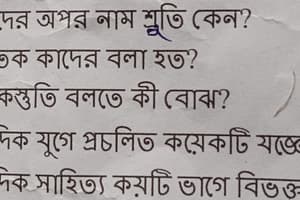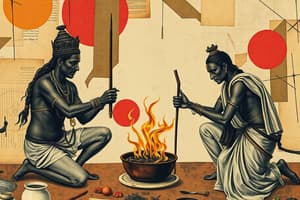Podcast
Questions and Answers
What linear unit is used in the construction of the Great Altar for the special sacrifice to Indra?
What linear unit is used in the construction of the Great Altar for the special sacrifice to Indra?
- 3
- Double-pace
- Tripler
- √ (correct)
Which proportion of the area is required for the smaller altar dedicated to Indra, compared to the Great Altar?
Which proportion of the area is required for the smaller altar dedicated to Indra, compared to the Great Altar?
- Two-thirds
- One-fourth
- Half
- One-third (correct)
What is used as the 'one-third-maker' in the construction of the smaller altar?
What is used as the 'one-third-maker' in the construction of the smaller altar?
- Double-pace
- √
- 3 (correct)
- Tripler
What dimensions are stated as smaller multiples of the √ unit's 'tripler'?
What dimensions are stated as smaller multiples of the √ unit's 'tripler'?
How many square paces is the Indra-sacrifice altar according to the text?
How many square paces is the Indra-sacrifice altar according to the text?
What is used in place of the double-pace in the construction of the Indra-sacrifice altar?
What is used in place of the double-pace in the construction of the Indra-sacrifice altar?
How are the widths of the Indra-sacrifice altar's eastern and western sides defined?
How are the widths of the Indra-sacrifice altar's eastern and western sides defined?
What is known about the area of the sacrificial altar dedicated to Indra?
What is known about the area of the sacrificial altar dedicated to Indra?
Flashcards are hidden until you start studying
Study Notes
Śulba-sūtras and Ritual Geometry
- The Śulba-sūtras are ancient Indian ritual practice texts that describe the construction of fire altars of specific sizes and shapes for different types of sacrifices.
- The altars were built using baked bricks of prescribed numbers and dimensions, with the footprint laid out on leveled ground using measuring cords of various lengths.
- The Śulba-sūtras provide terse, cryptic instructions, often in the form of verses, for constructing the altars.
- The texts describe area-preserving transformations of plane figures, including squares, rectangles, triangles, trapezia, rhomboids, and circles.
- The rituals required the transformation of one shape into another of the same size, involving geometric formulas and constants.
Authors and Historical Context
- The best-known Śulba-sūtras are attributed to authors Baudhāyana, Mānava, Āpastamba, and Kātyāyana, in approximately chronological order.
- The texts are ascribed to various ancient sages, but little is known about them beyond their names.
- The historical context of the Śulba-sūtras is unclear, with no contemporary texts that can answer questions about their origins.
Examples of Ritual Geometry
- In one ritual, a smaller altar is required for a sacrifice to Indra, with identical proportions to the Great Altar but only one-third of its area.
- The ritual requires replacing the linear unit with its "one-third-maker" or using smaller multiples of the tripler to achieve the desired shape.
- The altar dimensions are specified in terms of the double-pace and its tripler, with precise instructions for constructing the altar.
Studying That Suits You
Use AI to generate personalized quizzes and flashcards to suit your learning preferences.




